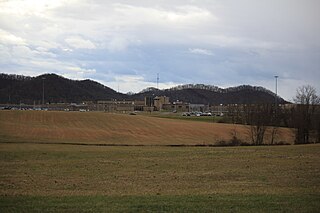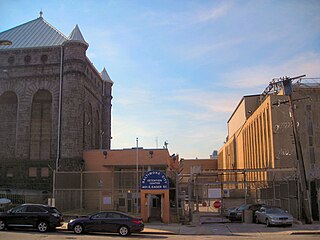
The Delaware Department of Correction is a state agency of Delaware that manages state prisons. It has its headquarters in the Central Administration Building in Dover. At one time the headquarters was located in Smyrna.

The Maryland Department of Public Safety and Correctional Services (DPSCS) is a government agency of the State of Maryland that performs a number of functions, including the operation of state prisons. It has its headquarters in an unincorporated area of Baltimore County, Maryland, United States, with a Baltimore address. There are additional offices in Sykesville.

Capital punishment was abolished via the legislative process on May 2, 2013, in the U.S. state of Maryland.

United States Penitentiary Florence Administrative Maximum Facility is a United States federal prison in Fremont County, Colorado, operated by the Federal Bureau of Prisons, a division of the United States Department of Justice.

A super-maximum security (supermax) or administrative maximum (ADX) prison is a "control-unit" prison, or a unit within prisons, which represents the most secure level of custody in the prison systems of certain countries.

The Federal Correctional Institution, Thomson, formerly United States Penitentiary, Thomson and Thomson Correctional Center, is a low-security federal prison located in Thomson, Illinois. It has an area of about 146 acres (59 ha) and comprises 15 buildings. The facility is enclosed by a 15-foot (4.6 m), 7000 volt electric fence surrounded by an additional 12-foot (3.7 m) exterior fence covered with razor wire. Thomson has eight cellhouses with a rated capacity of 2,100 beds—1,900 high-security SMU beds and 200 minimum-security beds at the onsite camp—and according to BOP officials, the potential to use some of its high-security rated capacity to house up to 400 ADX inmates. From its completion in 2001 to 2006, it remained empty. By 2009, only the minimum-security section housed prisoners.

CoreCivic, Inc. formerly the Corrections Corporation of America (CCA), is a company that owns and manages private prisons and detention centers and operates others on a concession basis. Co-founded in 1983 in Nashville, Tennessee, by Thomas W. Beasley, Robert Crants, and T. Don Hutto, it received investments from the Tennessee Valley Authority, Vanderbilt University, and Jack C. Massey, the founder of Hospital Corporation of America.

A prison officer (PO) or corrections officer (CO), also known as a correctional law enforcement officer or less formally as a prison guard, is a uniformed law enforcement official responsible for the custody, supervision, safety, and regulation of prisoners. They are responsible for the security of the facility and its property as well as other law enforcement functions. Most prison officers or corrections officers are employed by the government of the jurisdiction in which they operate, although some are employed by private companies that provide prison services to the government.
The Regional Reception Centre is a Canadian federal prison for men located with Archambault Institution at the Correctional Service of Canada (CSC) complex at Sainte-Anne-des-Plaines, Quebec, a short distance from Mirabel International Airport.
North Branch Correctional Institution (NBCI) is a high-tech, maximum security prison or "hyper-max prison" operated by the Maryland Department of Public Safety and Correctional Services in Cresaptown census-designated place, unincorporated Allegany County, United States, near Cumberland.

William C. Holman Correctional Facility is an Alabama Department of Corrections prison located in Atmore, Alabama. The facility is along Alabama State Highway 21.
Northern Correctional Institution (NCI) was a high-security state prison in Somers, in the northern part of the U.S. state of Connecticut. Until its closure, the prison housed the state's male convicts serving long sentences for violent crimes; previously, it had also housed the death row for inmates before the abolition of the death penalty in Connecticut.

The Varner Unit is a high-security state prison for men of the Arkansas Department of Correction in Varner, Choctaw Township, unincorporated Lincoln County, Arkansas, United States. It is located along U.S. Highway 65, near Grady, and 28 miles (45 km) south of Pine Bluff. The prison can house over 1,600 prisoners, and it includes a 468-bed supermax facility. The supermax and non-supermax facilities are separate from one another.

The Southern Ohio Correctional Facility is a maximum security prison located just outside Lucasville in Scioto County, Ohio. The prison was constructed in 1972. As of 2023, the warden is Cindy Davis.

The Maryland House of Correction, nicknamed "The Cut" or "The House", was a Maryland Department of Corrections state maximum security prison in an unincorporated area in Maryland. The prison opened in 1879 and became infamous for the high levels of violence that took place inside its walls. The state, under Governor Martin O'Malley, closed the prison in March 2007.

The Kentucky State Penitentiary (KSP), also known as the "Castle on the Cumberland", is a maximum security and supermax prison with capacity for 856 prisoners located in Eddyville, Kentucky on Lake Barkley on the Cumberland River, about 4.8 kilometres (3 mi) from downtown Eddyville. It is managed by the Kentucky Department of Corrections. Completed in 1886, it is Kentucky's oldest prison facility and the only commonwealth-owned facility with supermax units. The penitentiary houses Kentucky's male death row inmates and the commonwealth's execution facility. As of 2015, it had approximately 350 staff members and an annual operating budget of $20 million. In most cases, inmates are not sent directly to the penitentiary after sentencing but are sent there because of violent or disruptive behavior committed in other less secure correctional facilities in the commonwealth. This was Kentucky's second penitentiary: the first was made uninhabitable by a flood in 1937.

The Maryland Metropolitan Transition Center (MTC), formerly known as the historic "Maryland Penitentiary", is a maximum pre-trial security Maryland Department of Public Safety and Correctional Services prison located in Baltimore facing Greenmount Avenue between Forrest Street and East Madison Street. It was established in 1811 as the first prison in the state and the second of its kind in the country and the original buildings faced towards East Madison Street above the east bank of the Jones Falls stream and adjacent to the old stone walls of the Baltimore City Jail, earlier established in 1801, rebuilt in 1857–1859, and later in 1959–1965.

The New Youth Detention Facility in Baltimore City is a jail planned by the Maryland Department of Public Safety and Correctional Services (DPSCS). The facility is slated to be built between the 600 blocks of East Monument and East Madison Streets.

Baltimore City Detention Center is a Maryland Department of Public Safety and Correctional Services state prison for men and women. It is located on 401 East Eager Street in downtown Baltimore, Maryland. It has been a state facility since July 1991.
The Central Arizona Florence Correctional Complex, is a privately owned and operated managed prison located in Florence, Pinal County, Arizona. The facility is run by CoreCivic and houses prisoners for the United States Marshals Service (USMS), TransCor America LLC, U.S. Immigration and Customs Enforcement (ICE), Pascua Yaqui Tribe, United States Air Force, City of Coolidge, and City of Mesa. The majority are awaiting the resolution of their trials. The current population is male and female.















